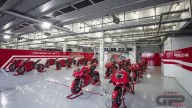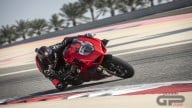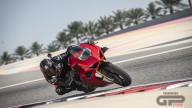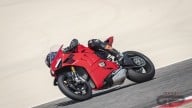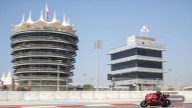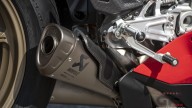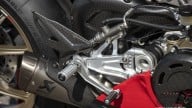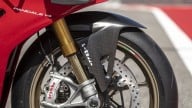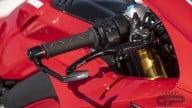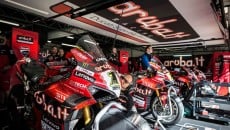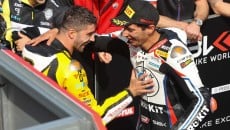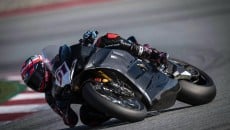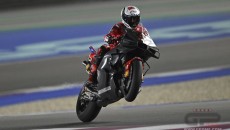by Luca Bono
A Ducati is a Ducati. You either love them or hate them. Because they have always been different from all the others and you don’t need to see the name on the tank to recognize them: just a glance will do. But it’s also enough just to hear their unmistakable sound. And when you try them, they captivate you with their strengths, even though some Ducatis also make you suffer for their shortcomings. Today we can say that defects are part of history, because it’s difficult to find any on the Panigale V4 2020.
A motorcycle from the Racing Department and 4,000 hp in the pits
In order to get the best out of it, Ducati engineers, like never before, have worked for two years in close contact with the Racing Department. Sharing the experience accumulated in Superbike and MotoGP to define the changes to be made to aerodynamics, chassis, suspension and electronics, with the aim of improving the bike, performance and riding confidence.
The bike is now easier, more intuitive, less fatiguing and faster, not only on a single lap, but also during a timed session. It is part of the philosophy of racing to give the rider an easier bike to go faster, not one that tires him, and makes him feel more rested for the last laps of the race where you have to give 100%.
Twenty V4s await us in the pits of the Bahrain circuit, 4,000 horsepower straining at the leash to enthuse testers who have come from all over the world for the preview test of the new 2020 Panigale V4 S. Already on its bike stand it exudes true grit: it immediately appears more ‘racing’ because you can recognize the innovations, the larger windscreen, the wider fairings and above all you can see the wings, which have been ‘taken’ from the MotoGP GP16 bike.
It’s difficult to hold back our excitement, we are here on the pit lane pawing at the asphalt and, as soon as the green light flashes on, it’s in with first gear and we power away from the long pit lane to enter the fast Bahrain circuit. A few laps to take the marker points and then you start pushing. We are faced with a task that becomes more and more difficult every year: putting a racing bike with a number plate through its paces is no longer a joke.
The Ducati Panigale V4 S drives the speedometer crazy: 290, 300, 310, 320!
As we power down the long straight that leads to the finish line, curled up behind the new fairing I can't even read the numbers on the dashboard, as they change so fast, 290, 300 ... then it resets to zero for safety reasons, but the top speed remains in the memory and you can see it once you are back in the pits.
And just think that the riding position is excellent: I am well protected by the fairing, there is no more pressure on the shoulders and arms thanks to the taller and wider windshield. It feels good tucked in and the bike seems to accelerate faster, without offering air resistance. All true, but the engine also plays its part; we reach Turn 1 at 316 km/h, and by squeezing the 330 mm discs I pass through in a few seconds at 50 km/h. The aerodynamic downforce generated on the front thanks to the wings is 40 kgs! The bike feels as if it’s on rails. I realize that the fairing works even when I lift up my torso due to braking, the impact with the air is less marked than in the past.
We had no doubts about the braking system, which is very powerful, but above all modular. Even when it feels like you're not going to make it, you always manage to recover a few meters! Only after a few turns, does the lever lengthen slightly, but this track has four braking areas where you go from 300 to 70-80km/h, which would put a strain on any braking system. The BMW and Yamaha systems, which tend to lengthen a bit for much less demanding braking, come to mind…
The ABS Cornering, from the new software, conveys so much confidence that in a couple of sections we came in a bit long, entering the curve with the brakes still well-gripped. In this way, we verified the Cornering functionality, which with a light pulsation on the lever warns us that we are really at the limit, and means that had it not been there, we would have ended up in the run-off area … probably in a horizontal position.
In braking, the softer setting of the suspension increases the load transfer with several advantages: the front bites the asphalt more effectively, the motorcycle is easier to turn into the corners, it is faster in reaching the curb and on the way it deals with any roughness better. So the V4 becomes easier for the amateur rider, and faster for the professional, it turns tighter and thus remains on lean for a shorter amount of time, allowing you to anticipate the opening of the throttle and make earlier use of all the output power of the V4, thanks also to the revised ride-by-wire mapping.
The Ducati sprouts wings and becomes more docile and faster
Turns 2 and 3 form a very technical ‘esses’, and in addition to the change of trajectory there is a slight descent followed by a sudden compression that presses down the rear and tends to lighten the front. Here we keep the gas open and we rely on the electronics, making the DTC do all the work. Only if we arrive with too much lean on the top of the hill with the gas wide-open at around 11,000 rpm does the rear slide, triggering a slight swaying, but it is really a borderline situation.
The V4 S is quick to change trajectory in slow corners, the effect of the new configuration, the higher centre of gravity and the revised calibration of the suspension, but what surprises us is that at the exit of the curve it has lost that typical V4 nervousness. We were ready to feel it sway a bit as it milked the mono-shock, yet instead we find ourselves with a more docile Ducati, neutral as if it were not forcing itself.
On exit you can appreciate the increase in chain pull, thanks to the shorter link and the increase in the rear height: the "anti-squat" effect during acceleration stabilizes the bike in this delicate riding phase and allows you to unload more power to the ground, following a narrower line.
We reach the braking point at Turn 4 after having stretched fourth and fifth gears up to about 12,000 rpm at 290km/h. Here begins another very technical section, a very quick downhill S-bend where moreover you cannot see the curb. A critical situation, in which the front end generally lightens on the top of the hill at the expense of feeling.
But even here the situation is different from what we expect, the wheels are planted firmly on the ground: the aerodynamic load on the front wheel is greater than about 16 kg – a weight that corresponds to the speed that is reached at this point, 200 km/h - and the slightly less rigid springs favour the load transfer and give greater feeling at the front when you release the gas and take the brakes in your hand. There is greater inertia in the fast change of trajectory, probably due to the aerodynamic effect of the wings. Slight manoeuvrability at the expense of greater stability.
It's strange ... but we trust it
We only change the EBC (Engine Brake Control) after a few laps, because we want a little less engine brake to keep the bike sliding in the fast, downhill left-hand curve that you do with the throttle closed. The EBC EVO of the Panigale V4, which also works by evaluating the lean angle, conveys a lot of confidence and the terrifying very fast downhill becomes a fun slide, useful only for shaving off the final tenths lap after lap. This feeling of stability and safety was unthinkable with the previous V4. We even pass over the slight depression in the middle of the curve without hesitation, thanks to a softer calibration of the suspension and the less rigid frame, which conveys more confidence at maximum lean.
The braking sections of Turn 8 and Turn 10 are very demanding because you arrive with the bike on lean, and they are then followed by sudden acceleration. We switch over from the Riding Mode Race to the Sport one, less extreme, to have a softer engine delivery, more invasive controls, but above all to try the ABS in map 2, which leaves the drift and rear wheel lift control to the electronic management. It feels strange not to manually "check" this delicate phase of the braking, but we trust it and realize that it can be a valuable aid for the less experienced.
We put the Race map back for the last laps. We exit Turn 10, a tight hairpin bend of 70 km/h. Over time, confidence increases, and we open the throttle more determinedly, trusting the controls completely. First touch opening of the throttle is incredibly soft, there is no jerking, no hesitation, all contributing to confidence, performance and the durability of the rear tyre. The bike then doesn’t go wide, doesn’t swerve, but makes its own way and comes out nice and tight.
We notice a big difference between the V4 S and the V4 S with the Akrapovic Racing exhaust that we try in the afternoon, the latter with 12 hp more and weighing 6 kg less. The bike has more resilience especially at medium revs and the gas/rear wheel connection is perfect. We manage to ride the V4 with the throttle and make it drift as and when we want in the long third-gear corners. In the pits our eyes are sparkling, and we have a smile on our faces! The new mapping of the 2020 V4 model manages the torque better, and there is greater linearity between the request, i.e. the opening of the throttle and the torque delivered. Dosing the gas becomes easier and above all makes the reactions of the rear more predictable.
Too soft? It’s more effective
Power delivery has been softened in the first three gears to contain the stability losses during acceleration. At first approach, the V4 seems all too tame between 5,000 and 8,000 rpm, but as the laps go by, you appreciate the fact that you have a less nervous, more effective and also less tiring response. Only at the exit of the slower 60 km/h corners would we want a little more power from 4,500 to 7,000 rpm. You no longer open the gas wide with qualms about feeling the rear slip and the motorcycle move abruptly in acceleration. It will be interesting to see if Ducati has managed to close the gap in terms of traction compared to Yamaha and BMW. The direction seems to be the right one for Ducati to find itself ready for the next comparison.
On the return straight we squeeze out the maximum 214 hp at 13,000 rpm of the V4 S which thanks to a torque value of 12.6 kgm shoots us between the curves of the very fast Bahrain circuit like a bullet. At this point we find the use of the DWC (Ducati Wheeling Control) very useful, which by using the information of the inertial platform controls the wheelie and allows you to obtain maximum acceleration performance with ease and safety. It is very important to find the right setting, because if it is too intrusive the bike cuts a lot of power and exits the corners with less thrust. We test it up to level 1, the least intrusive, but the operation is too free both in the tendency to wheelie and in coming back down again, much too abrupt.
Thanks to the wings, 25 kg on the front and electronics are used less
Then begins the most beautiful part of the track: the 200 km/h ‘esses’. Turn 11 is a long uphill left-hander where you enter very strongly, let the bike slide to the centre of the track, and then with the gas closed and by pinching the rear brake, you can bring it back to the curb. It resembles the Pons curve at Jerez, with the difference being that at the exit there isn’t a straight, but a very fast right bend that you do with a 50 degree lean, with the gas wide open and the bike that drifts leaving long black lines: it is impossible to describe the adrenaline rush that the V4 transmits in this part of the track.
It is the most technical point, where you remain with bated breath for a few seconds and to make the difference it takes nerve. It is a perfect section to appreciate the aerodynamic advantage offered by the wings, which at 250 km/h increase the load on the wheel by about 25 kg, reducing front wheel float and the tendency to wheelie. They improve stability during braking, entry and cornering and the overall effect improves the lap time, because it reduces the intervention of the electronic controls and allows you to keep the throttle open for longer and to brake later.
Between Turns 11 and 12 you go into third gear, a delicate situation because the lean exceeds 50°. Here the new DQS EVO 2 electronic gearbox, which derives from the Panigale V4 R, is precious because it uses information on the lean angle to ensure stability when changing gear during cornering. In fact, when the bike is leaned it softens the cut in power, thus reducing the swaying that would be generated by the classic clean procedure.
On the straight, on the other hand, it optimizes speed, reduces cut-off times and ensures sportier gear changes at high revs, over 10,000 rpm. It also allows you to upshift without using the clutch, ensuring even more effective braking. It is only in last-ditch braking when you go down from sixth to second that sometimes it’s hard to put in second gear immediately. The system probably reads a speed higher than what is allowed and to avoid overrevving it doesn’t allow the gear to go in immediately. Just pinch the dear old clutch and you're done….
Turn 12 allows you to try also the DTC EVO 2 (Ducati Traction Control) and DSC (Ducati Slide Control), systems that work with the 6-axis inertial platform that instantly detects roll, yaw and pitch angle and they manage all the riding phases: start, acceleration in corner entry, exit and braking. The new software significantly improves power management at the exit of the corners, thanks to its predictive control strategy: the interventions take place in a much more fluid and linear way, thus reducing peaks in slippage, and therefore oscillations, and this translates into a greater stability when corner exit and improved performance over both one lap and on long runs.
Sliding under control and grip is never lacking
On my 12 o'clock run, the DSC (Ducati Slide Control) yaw control also intervenes very well. It works by adjusting power delivery according to the slide angle, thus improving acceleration out of corners and avoiding excessive sliding that is difficult to control, and which could end up with a dangerous highside. We also tried the least invasive level and the bike oversteers even more, but you need to have a lot more mileage behind you to learn how to take advantage of this precious electronic aid.
The ups and downs of the Bahrain track also put the Ducati Electronic Suspension (DES) EVO electronic suspension system under pressure. The S version we are riding is equipped with Öhlins suspension, electronically controlled by the Öhlins Smart EC (Electronic Control) system which exploits the potential offered by the inertial platform: in Dynamic mode it automatically adjusts the compression and rebound damping, adapting to the riding style.
In the heaviest braking sections, the front fork always offers good support and good softness, and goes down gradually, offering an excellent feeling at the front. Even the monoshock works well, it is progressive and offers an excellent response even in acceleration at maximum lean. In the Riding Mode Sport, on the other hand, the suspension is a little too soft for racing use.
A big round of applause goes to the tyres, which allowed the V4 to show itself at its best and discharge all of its 226 hp to the ground. We used the SC1 compound Pirellis, in sizes of 120/70 front and maxi 200/60 at the rear, the same used in the FIM Superbike World Championship, a race replica tyre. What surprised us is not only the grip, which can be said to be infinite, but also the ease with which you can put down all the horsepower onto the ground with maximum safety. Then there is what has always been the Pirelli strong point: braking. Confidence is excellent, not only when you go from 300 to 50 km/h with a straight bike, but in particular when you enter a corner pinching the brakes, you have the maximum feeling of support, without any self-righting effect.
Defects? Tiring in braking. 'Lorenzo's tank' would be needed
In the last, and sixth shift at our disposal, we decided to simulate an 8-lap long run at full throttle, to verify the consistency of the race pace declared by Ducati technicians. We start to push from the first to the last stage, only by focussing on riding and without thinking too much about the operation of the various controls. The bike is easier, the physical effort required is less, and so you can easily reach and maintain your limit, because the reactions are more predictable.
After a few sessions, however, we notice fatigue in the arms, due to the ergonomics of the fuel tank which, in our opinion, could be improved to better anchor the knees in braking, distributing the force also on the legs. The wide handlebars are useful for having more torque on the bars and make the bike more manageable, but at the same time they tire the arms, in particular in circuits like Bahrain where long and very fast straights alternate with very slow curves. Better ergonomics would allow greater control even in centre curve, allowing the knees to grip the tank better and transfer more force to the footrests.
Ducati did the best thing to follow the strategy of the Racing Department: the riders, but especially us testers, liked the 2020 V4 model because it reduces physical effort and leaves more time to control the bike but above all to have fun!
Ducati gives everyone the opportunity to try the V4 2020, but above all to learn how to use it to the fullest thanks to the support of Ducati technicians and a team of federal instructors who make their experience available to improve their riding technique on the track during DRE (Ducati Riding Experience) courses. Info on www.ducati.com









